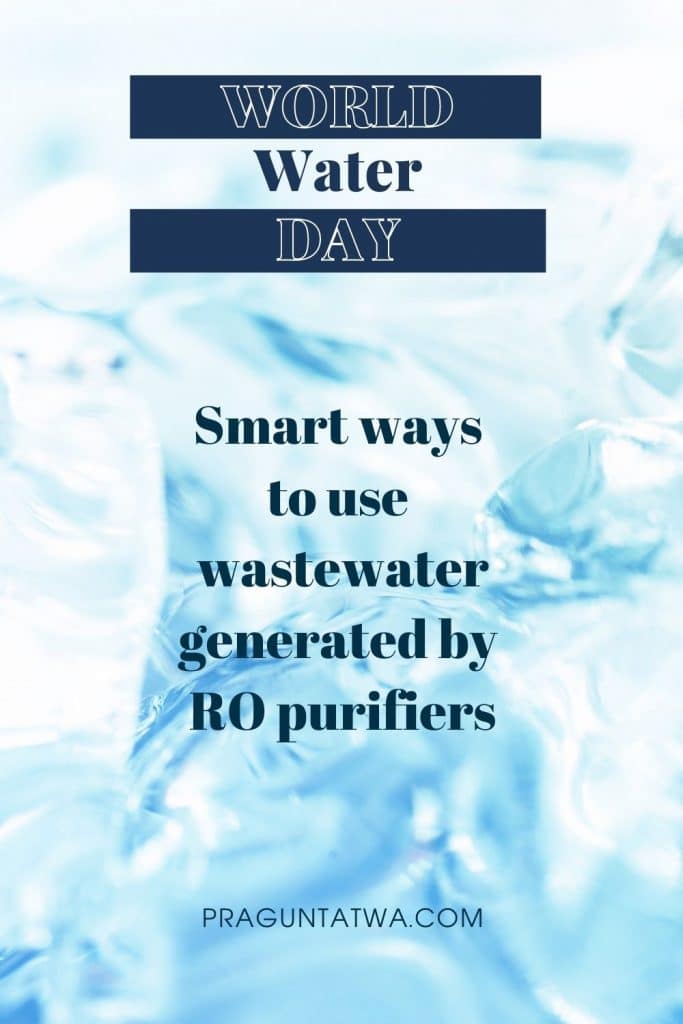Smart ways to use wastewater generated by RO purifiers

“Water is life’s matter and matrix, mother and medium. There is no life without water.” Conserve water. – Albert Szent-Gyorgyi
Summers are nearing and so is there an increase in the water intake. Most Indian homes use RO water purifiers, but have you ever noticed the water wastage caused due to this process. When you fill one bottle of water, in return double the water goes waste down the drain. It’s high time we utilize that water and put it to better use. One just needs to know about some easy ways to reuse RO wastewater, and then take action accordingly.
RO water purifiers
RO i.e. reverse osmosis, using RO water purifiers not only gives us safe, clean, and tasty water but also protects us from life-threatening waterborne diseases. But there is one big drawback of using RO water purifiers i.e. the excessive wastage of water. A study says an average RO purifier wastes approximately 3 liters of water for every 1 liter of purified water. That means only 25% of water is purified and 75% of water comes out as waste, which just passes down the drain.
Water wastage
Have you ever wondered why so much water is wasted in the RO process? Reverse Osmosis (RO) purifiers use membrane technology to filter dissolved impurities, the impure water is filtered out and is often called wastewater or reject water. The percentage of wastewater varies according to the RO purifier being used. so a certain amount of water is wasted during this purification process. All this occurs due to its membrane technology that requires additional water to clean the filter, which is later discharged.
Ways to reuse RO wastewater
Due to the high content of total dissolved solids (TDS), this water is unsuitable for drinking, but you can put it to good use by taking some simple measures.
The easiest way would be to drop the reject pipe in a bucket. But if your daily drinking water requirement is 20 liters then on average your RO water purifier would generate around 60 liters of wastewater. You can extend the RO waste pipe and drop it in a big tank placed outside your kitchen. This stored water can later be re-used in one of the several ways listed below.

Floor Mopping
Using the RO wastewater for mopping the floor is easy and will definitely save tons of liters of clean water every day. Dilute waste RO water with an equal quantity of tap water. Because plain Reverse Osmosis wastewater with high TDS may stain or leave salt particles on the floor. Another option is to use the RO wastewater for floor mopping on alternate days. This will reduce the chances of any stains or salt deposits.
Cleaning and Flushing Your Toilets
Ever wondered how much water goes down the drain when you press the flush button? A big source of clean water wastage in modern homes is the use of toilet flush. Every single flush sends approximately 5 to 7 litres of potable water down the drain. here, RO wastewater can be used effectively to reduce this wastage of clean water by using it to flush your toilets. When you start, always monitor your toilet seats for any discoloration on porcelain surfaces after a few days. With a periodical cleanup using common toilet cleaners, the chances of discoloration and salt deposits can be avoided.
Rinsing light Laundry
You can use the RO wastewater for daily laundry as well, but please keep in mind that using high TDS water might not be suitable for some delicate fabrics. Most Indian homes now use washing machines, though washing machines save a lot of time and effort but also result in a lot of wastage of water. You can create an overhead tank that collects the RO wastewater and use the wastewater from this tank directly in your washing machine (do keep in mind the fact about delicate fabrics)? This tip works best for semi-automatic & twin tub washing machines.
Wash Your Car
A single car wash consumes approx 10-14 liters (for car wash using a bucket) to 75 liters (for car wash using a hosepipe) of water. Just think of the scarcity of drinking water, using so much potable water for car wash seems unreasonable and equivalent to crime.
If you are using an RO water purifier at your home or office then you can simply store the wastewater in some tank or bucket and reuse it for washing your car. Water with a TDS level of 1200 – 1500 PPM can be safely used for car washing.
Watering Your Plants or Home Garden
This wastewater can be used for watering your plants to keep your indoor or terrace garden green. If you are someone who loves gardening or have planted some plants in pots, you will surely love reusing and putting this wastewater to better use. This tip is particularly useful for people living in urban areas as the TDS level in municipal water tends to be lower.
To be on the safer side, you can start with a few plants. Use the RO wastewater for 15-20 days and check its effect on the growth of your plants. Each plant will respond to this change differently, which will give you a clear understanding of which plants are responding better to RO wastewater.
Wash Your Utensils
Another useful application for Reverse Osmosis wastewater is to wash your utensils. Simply store the wastewater in a bucket or tank, make sure you place the bucket for collecting RO wastewater near your kitchen sink so it can be used easily when you clean your utensils.
We found this useful YouTube video that shows you how you can easily re-use the RO wastewater in your kitchen for washing utensils.
Use it for household chores
You can put waste RO water to good use by using it to wash or clean your front or backyard.
Sewage pipe cleaning
The waste RO water can be used to clean sewage pipes at home or in the kitchen because of its saline nature.
Bathing pets
Waste RO water can also be used to give your pet a bath. But always dilute it with the same amount of normal tap water before doing this. You should also dry your pet after bathing.
To fill the room cooler
You can use the wastewater to refill your room cooler as well. Add some normal tap water and re-use the rejected water.
Water is precious and we read and listen every year to the news of farmers committing suicide because of droughts. And there are thousands and lakhs of families in our country who have to travel for miles every day to collect drinking water. If you are fortunate enough to be blessed with a sufficient water supply, think of it as a privilege. Don’t waste water and put the wastewater to better use, try to reuse RO wastewater in every possible way. Do your bit by saving every drop of water. These small measures can really make a lot of difference because EVERY DROP COUNTS.
To sum up, This is my conscious lifestyle post to spread more awareness about sustainable living. and Join me for more such ways and tips and become part of my Conscious and sustainable living journey. Keep visiting my blog to make yourself eco-friendly, aware of conscious and sustainable choices and be more concerned for our environment, and alter your lifestyle.
Being Eco-Friendly is not a choice, make it a habit.
To add on, Read and listen to my Green talks series and check out interviews with Eco-conscious people who are trying their bit towards conscious and sustainable living practices. There is so much to learn and explore from all of them I had interacted with, do listen and drop in your views in the comments. Check here to know more about all the Eco-Friendly dates








This article on RO Purifier is very helpful as it contains great information. Thank you so much for your help i really appreciate it.